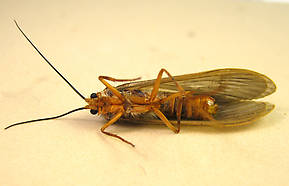Blog & Latest Updates
Fly Fishing Articles
Insects by Common Name


Fall Caddisflies
This common name refers to only one genus.
Caddisfly Genus Dicosmoecus
These are sometimes called Fall Caddisflies.
This is a superhatch in the West. Gary LaFontaine had a self-proclaimed obsession with Dicosmoecus, and he devotes several pages of Caddisflies to stressing the importance of its larvae, pupae, and adults. He wrote:
His reasons for this judgement are five traits of Dicosmoecus:
I have never fished the West to experience Dicosmoecus, but I have enough experience with Hexagenia limbata to know that a greater insect must be truly amazing.
The question for fly fishermen seeking big trout is: "Which insects provide the best opportunity for catching such fish?" My list would be: Giant Orange Sedge (Dicosmoecus sp.), Salmon Fly (Pteronarcys californica, a stonefly), and the Michigan Mayfly (Hexagenia limbata). Dicosmoecus is the most important -- and the contest is not even close.
His reasons for this judgement are five traits of Dicosmoecus:
- Very large size: Adults 30mm long, and thick.
- Activity concentrated within 2-3 weeks.
- Emerges in the low, clear water of fall.
- Active during afternoon and evening.
- Abundant in rivers with sea-run trout.
I have never fished the West to experience Dicosmoecus, but I have enough experience with Hexagenia limbata to know that a greater insect must be truly amazing.
Female Dicosmoecus atripes (October Caddis) Caddisfly Adult View 6 PicturesThis specimen is 26 mm.
View 6 PicturesThis specimen is 26 mm.
- Entoman
 View 6 PicturesThis specimen is 26 mm.
View 6 PicturesThis specimen is 26 mm.- Entoman
See 2 more specimens...
Top 10 Fly Hatches
Top Gift Shop Designs
Eat mayflies.
Top Insect Specimens
Miscellaneous Sites
Troutnut.com is copyright © 2004-2024 Jason
Neuswanger (email Jason). See my FAQ for information about use of my images.
 privacy policy
privacy policy

